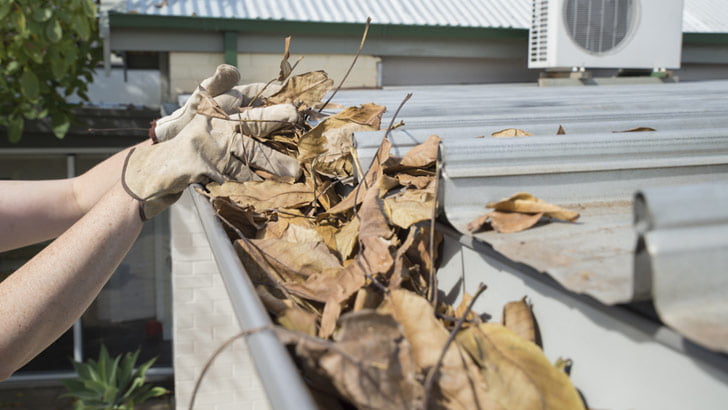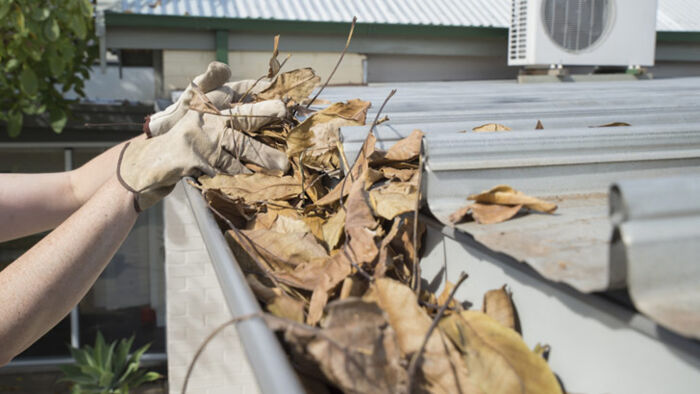The prediction of a third La Niña event bringing above average rainfall for northern and eastern Australia is a major concern
for homeowners.
The ground is already very wet and the streams and dams are full, so we need to prepare our homes as much as we can because surface runoff can happen quickly. Knowing the areas of your home that have been affected by hurricanes and floods in the past can help you be prepared and potentially lessen the impact in the future.
Maybe you moved house since last hurricane season? Have you done your research on how your area has been affected by past hurricanes?
Your local council can usually provide flood maps for your location.
Storm proofing your home is always money well spent. Designs that can withstand our harsh times have come a long way, so adding timeless materials doesn’t mean sacrificing quality interiors. Let’s see how you can prepare your home for typhoon season.
1. Drains and downpipes
Make sure gutters and downpipes are free of blockages. It can make a big difference. Clogged gutters and downpipes create overflows under roofs and into the roof cavity, resulting in costly damage.
Likewise, the drainage systems around your home should be clear of all debris so that storm water can flow freely. Check around your home to see if there are any loose objects that could be causing blockages.
If you feel like your gutters and downpipes are too small and haven’t fared well in past storms, an upgrade may be in order. Getting quotes from qualified roofing plumbers will guide you to the best outcome. To have your drains cleaned by a professional costs about $95 to $210.
2. Landscaping upgrades
A smart hurricane plan is to use mother nature to your advantage.
Although it is difficult to control the flow of water, some plants and outdoor surfaces can absorb it. Planting trees and using landscaping products like gravel and/or bricks can improve your storm resistance.
Creating channels in your landscaping allows you to redirect water away from your home. The drainage system that surrounds your property plays an important role in determining the path that stormwater will take.
3. Carpet alternatives
If your home has been affected by water intrusion in recent times, chances are you will face it again. Consider switching your flooring to a product with better water management capabilities. Non-absorbent materials may be worth considering. Removing the carpet and replacing it with tile and concrete floors can be a good investment.
4. Seal your house
Cracks in the foundation can allow water to seep in. Making sure your home is professionally sealed is important. A small crack in the foundation can cause tens of thousands of dollars in damage.
Contact a qualified builder to analyze your foundation and check for signs of water damage from past storms. They can then give you a cost estimate to seal your home to keep outside water out.
Exterior windows and doors are also subject to our harsh Australian conditions. They can warp, shrink and expand, preventing operability.
Maintaining these areas to ensure they are fully functional should be on your list before hurricane season. It is important to remember that aluminum frames are stronger than wood. A thorough inspection of the integrity of your roof is also important work. A roofing professional can repair any damaged or missing tiles.

5. Electrical
Consult your electrician and discuss your concerns from last season. Placing your power points on a higher wall to help prevent damage should storm water seep into your property can be beneficial. Can your electrical appliances be moved easily?
Make a plan for your washing machine, dishwasher, TV and all electrical appliances to be placed in a higher location (if possible). Maybe find some bricks to lift these things off the floor should moving not be an option.
6. Pipe inspection
Taking a proactive approach to past storm-related problems can help protect your home. Engaging a plumber to discuss your concerns is a good investment.
A professional can visit your home and inspect the sewer lines and make sure your plumbing is working as efficiently as possible.
By analyzing your property and determining if there are any weaknesses, they can improve your flood protection. There is no substitute for professional guidance here.
7. Work together
If the storm affects your property, there is a good chance that your neighbors will be affected as well. How has the storm water filtration in your neighborhood been in the past?
By working and planning with your neighbors, you can ensure that your projects are more sustainable as a joint effort.
8. Sandbags … just in case
Stocking up on sandbags can go a long way in keeping water away from your home in an emergency. Stormwater can easily become floodwater if the ground is still saturated from previous storms.
Sandbags can be collected from your local SES center or purchased from your local landscaping supplier. Take the time to get it now and you’ll avoid the rush when hurricane season approaches.
9. power supply
It is useful to have an alternative supply if you lose power or if the authority has to cut off your supply.
As we have learned from historical events, it can take several days to restore power when an entire community is affected. Investing in a generator gives you the ability to keep your home running, keeping your fridge/freezer running.
Fuel supply is also essential. Generators can be purchased from $600.
10. Prepare a plan
Knowing how and where to turn off electricity, water, gas and solar is important. Creating a map of your property that clearly marks the location of your electrical switchboard, gas connection, water supply and solar inverter will enable quick action in the event of an emergency.
If you are unfortunate enough to have your home flooded with flood water, be prepared to remove the damaged materials and speed up the drying process as soon as possible. Only licensed electricians should access your switchboard or electrical equipment if it has been affected by a flood. Remember, when in doubt, get professional advice. Don’t risk your life.
The more you do to prepare now, the less likely you are to need help in an emergency. Tackling a few simple projects around your home can make a big difference and ensure you are well prepared before hurricane season.
Get stories like this in our newsletters.

